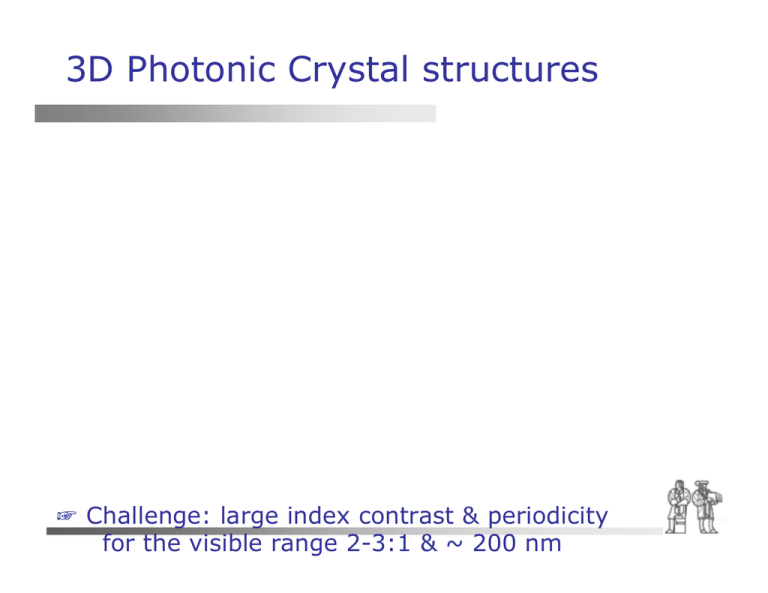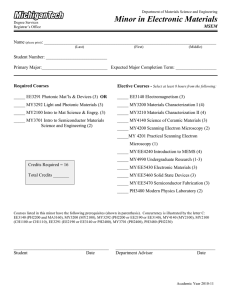3D Photonic Crystal structures ☞ Challenge: large index contrast & periodicity
advertisement

3D Photonic Crystal structures ☞ Challenge: large index contrast & periodicity for the visible range 2-3:1 & ~ 200 nm Nature's Photonic Crystals 1-D: Courtesy N_yotarou. Image from Wikimedia Commons, http://commons.wikimedia.org. Images removed due to copyright restrictions. Please see 2-D: http://www.physorg.com/newman/gfx/news/2005/sem_mop.jpg http://www.physics.usyd.edu.au/theory/seamouse/TheAnimal/spine.x64.jpg http://www.physics.usyd.edu.au/theory/seamouse/TheAnimal/figure2.jpg http://www.icmm.csic.es/cefe/Imagenes/manhattan.gif 3-D: Photonic Materials k/⁄ → E n1 n2 n1 n2 n1 n2 k k⊥ → B Periodic variations in dielectric properties cause particular propagating modes to be forbidden a E. Yablonovitch PRL 1987 Periodicity can be 1-D, 2-D and 3-D giving rise to photonic properties of the same dimensionality. Understanding Band Gaps: Periodic Dielectric Modulations f(x) = 0 defines IMDS Modulations in Principal Directions Superposition of Modulations in 2D Periodic Bicontinuous Structures Marine Biologists “Cidaris Cidaris: Rectilinear” Self Ass’y Community: “Plumber’s Nightmare” Mathematicians: “Schwarz’s P Surface” Image removed due to copyright restrictions. Please see any image of the Schwarz P surface, such as http://www.msri.org/about/sgp/jim/geom/minimal/library/P/imag/s_end.jpg Sea Urchin: Cidaris Cidaris Image removed due to copyright restrictions. Please see any page on sea urchin anatomy. • Cidaris cidaris: found off Shetland Isles • Inhabit deep water (30m) and usually in predominantly sandy areas where they can sometimes be found in large numbers. Cidaris Cidaris Stereom Image removed due to copyright restrictions. Please see http://www.ucmp.berkeley.edu/echinodermata/stereom.gif 2mm 100μm • Composed of high magnesium calcite, a calcite (CaCO3) that incorporates up to 15% MgCO3. • The skeleton can be seen to be comprised of a threedimensional meshwork, known in the mathematician’s language as the P-surface. Photonic Crystal Engineering of Cidaris Cidaris • For the native structure, the bandgap will appear approximately at λ=50 μm. • Size reduction scheme Te/air – (fill, cure, etch, heat, fill…) (P)DMS/CaCO3 SiO2/Te SiO2/air PDMS/air Original Structure CaCO3/air SiO2/Styrene (P)DMS/PS Inverse Structure (P)S/CaCO3 PS/air P-surface Family: 50% vol, n2/n1 = 4.6 Image removed due to copyright restrictions. Please see Fig. 1c in Ma, Yung-Hoon, et al. “Three-Dimensional Network Photonic Crystals via Cyclic Size Reduction/Infiltration of Sea Urchin Exoskeleton.” Advanced Materials 16 (July 5, 2004): 1091-1094 No complete gap! P-surface Family: 19 vol%, n2/n1 = 4.6 Skeletal graph of tellurium and air (vol fraction = 18.6357%) 0.5 v v v v v v v v v v v v v v v v v v v v v v v v v v v v v v v v v v v v v v v v v v v v v v v v v v v v v v v Frequency (c/a) 0.4 0.3 v band 1 band 2 band 3 band 4 band 5 band 6 band 7 band 8 band 9 band 10 0.2 0.1 0.0 L 2 complete gaps! R M L X M Figure by MIT OCW. Gap Map for n2/n1 = 4.6 Gap maps are useful for finding optimum structures and fill fractions 0.55 0.50 best Frequency (c/a) 0.45 Band 5 and 6 0.40 0.35 0.30 Band 2 and 3 0.25 0.20 0 5 10 15 20 25 30 35 40 45 50 Filled volume fraction (%) Figure by MIT OCW. Modulations in Principal Directions f(x,y,z) =sin[2πx] + sin[2πy] +sin[2πz] Superposition of sinusoidal modulations in 3D ωa / 2IIc 0.8 Gap Map 0.4 0.0 0.0 0.5 f Complete Gap f.o.m. ~ 13% @ 0.26 dielectric network n2/n1 = 3.6 1.0 Figure by MIT OCW. BCP Photonic Crystals 1D: Lamellae 2D: Cylinders 3D: Double Gyroid (e) Images removed due to copyright restrictions. Please see Fig. 2a in Urbas, (c) Augustine, et al. “Tunable Block (c)(c) Copolymer/Homopolymer 1 μm Photonic Crystals.” Advanced Materials 12 (2000): 812-814 Please see Fig. 2 and 3 in Urbas, Augustine, et al. “Bicontinuous Cubic Block Copolymer Photonic Crystals.” Advanced 250 ber nm 17, Materials 14 (Decem 2002): 1850-1853 1 μm 1 μm 11 μm μm 100 Full Width = 6nm Reflectivity 80 60 40 20 0 200 300 400 500 600 Wavelength (nm) 700 800 Courtesy Elsevier, Inc., http://www.sciencedirect.com. Used with permission. 1D Dielectric Stack: Multilayer Films from Lamellar Block Copolymers Symmetric A/B BCP systems form regular lamellae Tailor period via blending of low MW homopolymers Polyisoprene n=1.51 Polystyrene n=1.59 lamellar repeat spacing lower Mw homopolymers high Mw BCP Ternary Blending: A/B, hPA, hPB Two Swelling Models: • Volumetric • Linear L=L0(1+ϕHP1/3) Low MW L0 High MW A. Semenov, Macromolecules 26, 2273 (1993) L= L0(1+ϕHP) 650 Measured Wavelengths of Peak Reflectivity Mixed swelling with 70% segregated 600 550 205 190 175 Segregation Swelling 500 160 450 145 400 130 Solubilization Swelling 350 115 100 300 0 10 20 30 40 50 60 Lamellar Spacing (nm) Wavelength of Peak Reflectivity (nm) Normal Incidence Band Gap Position vs Homopolymer Fraction The reflectivity can be tuned to a selected wavelength The morphology is maintained over this range of homopolymer fractions and the spacing changes by a factor of two Percentage of Homopolymer Added to Blend With a 3 component system, peak can span over visible spectrum Reflectivity from Block Copolymer/Homopolymer Blends Selected Blends of 194k/197k S/I BCP with 13k hPS and hPI Samples are free cast in air from toluene. Images removed due to copyright restrictions. 70 Percent Reflectivity 60 Please see Fig. 1a and 2a in Urbas, Augustine, et al. “Tunable Block Copolymer/Homopolymer Photonic Crystals.” Advanced Materials 12 (2000): 812-814 5% 40% 50 50% 20% 40 30 20 300 400 500 600 700 Wavelength (nm) Figure by MIT OCW. Typical reflectivity is 60% and samples have a Δλ/λ of 0.15-0.25 Block Copolymer Gels As Sensors Paint-on pressure sensors • Photonic polymer solutions from a BCP and a non-volatile solvent • Highly viscoelastic with sufficient solvent • The layer period is sensitive to mechanical deformation Chemically Tunable Photonic Bandgap Gels Lamellar PS(190K)-b-P2VP(190K) P2VP block is crosslinked and quarternized Concept: Collapse Transition Gel Layers - Selectively modulate the optical thickness of the P2VP layer by swelling, consequently changing the photonic bandgap and the reflected color Æ Æ Gel layer volume can be up to 100 times of the initial polymer layer volume very large differences in refractive index and domain size; reflected wavelength can be varied with the degree of swelling Chemically Tunable Polyelectrolyte BCP Gels Lamellar PS(190K)-b-P2VP(190K) P2VP block is crosslinked and quaternized 2.5M NH4Cl 1,4 dibromobutane (DBB) vs. 1 bromoethane (BE) Y. Kang et al., unpublished Concept: Rod - Coil Collapse Transition of Gel Layers Selectively modulate the optical thickness of the QP2VP layer by swelling/deswelling, consequently changing the photonic bandgap and the reflected color Æ Æ Gel layer volume can be up to 100 times of the initial polymer layer volume Very large differences in refractive index and domain size; Reflected wavelength can be varied with the degree of swelling Water Swelling of Polyelectrolyte BCP Gels TEM Dry BE only Crosslinking Controls Fully Swollen Color Swollen Highly Responsive UV to IR Tunability and Multiorder Band Gaps Visible 4 4 5 100 3 Reflectivity (%) 5 c = 0.0 M 2 1 3 1 2 c = 0.075 M 4 80 2 calculated data ( φ H2O = 0.91) 60 40 1 experimental data ( c = 0.0 M) 20 0 3 400 2 3 800 1200 1600 Wavelength (nm) 1 NH 4 Cl (M) 2 2.5 1 c = 0.5 M 2.0 1.5 1.0 0.5 0.0 1600 2 1 :experimental data (upper x axis) c = 1.0 M 1 c = 1.5 M 1 c = 2.0 M 1 Peak Position (nm) A bsorb a nce (a.u.) c = 0.25 M :theoretical calculation (lower x axis) 1200 800 1 c = 2.5 M dry 400 800 1200 Wavelength (nm) 1600 2 400 3 0.45 0.60 φH O 2 0.75 5 4 0.90 Photonic Block Polymers & Electro-optical Polymers Using Block Copolymers As Host For Conjugated Sensory Polymers- Self-Assembled Lasing Cavities Ability to microphase-separate In 2D and 3D structures Stimulated emission in conjugated polymers OR BCC hex gyroid OR' lam RO n R'O S2 Figure by MIT OCW. Increasing Weight Fraction Block A S1 h⋅υ S0 h⋅υ′ Grafted Poly(phenylene ethynylenes): Enhanced Emission and Alignment with Host Matrix ( )m O Higher Quantum Yield Than Ungrafted Polymer O C11H22 O O C16H33O C11H22 O OC16H33 n O Using ABA block copolymer as template for PS grafted PPE R' X X • Highly anisotropic structure • No aggregation n



